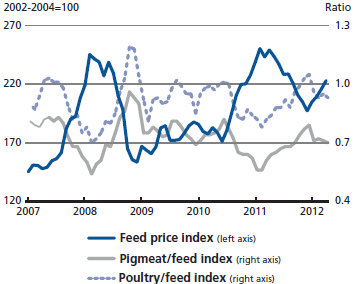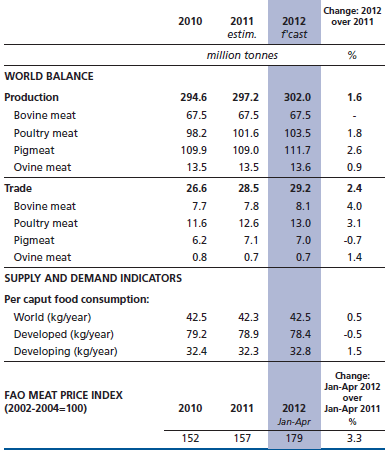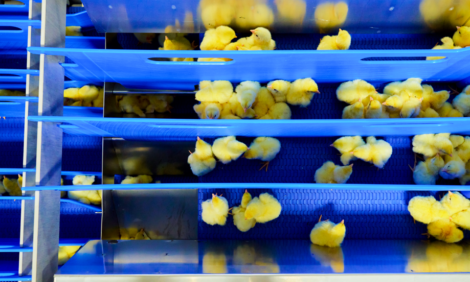



Food Outlook – Meat and Meat Products
Global meat markets in 2012 are expected to see a recovery of supplies in traditionally importing countries and strong competition for markets, according to the latest Food Outlook report from FAO. Near record prices are constraining consumption growth.Meat Prices Hover at Near–Record Levels
Global meat markets are likely to face heightened trade competition in 2012, at the same time that recovering
meat production in Asia is set to dampen growth in global
import demand. Overall, meat trade is expected to expand
by two per cent, to 29.2 million tonnes, much of which is
anticipated to be taken up by developing country exporters,
which could increase their share of the global trade to 44
per cent.
Disease outbreaks in 2011, drought–reduced cattle
inventories and high feed costs sustained international meat prices to near record levels in the first quarter of 2012. In
April, the FAO meat price index edged up to 182 points,
surpassing the record 181 points registered in November
2011.


Indications of slowing import demand, especially for pig and poultry meats, portents a potential moderation of meat prices in the coming months, which, along with high feed costs, is raising concern about the profitability of the meat sector in 2012.
Poultry Meat
Poor returns to limit production growth in 2012
Growth of the poultry sector, historically one of the most
dynamic meats, is being dampened by high feed prices, the
resurgence of avian influenza (AI) outbreaks in Asia and ongoing
trade disputes. As a result, global output is forecast to
rise by only two per cent to 103.5 million tonnes in 2012.
Much
of the increase will likely originate in Asia, in particular in
China, India, Japan, the Republic of Korea and Turkey.
However, escalating cases of AI, with a record seven
countries in Asia reporting outbreaks in February, clouds the
region’s production outlook. In Bangladesh, an estimated
6,000 poultry farms have closed since the beginning of
the year because of AI and high feed costs.
In Africa, the
spread of AI to Egypt in early 2012 is expected to hinder the
development of the sector in the course of the year.
Declining output in the United States, as indicated
by falling chick placements in early 2012, and only slight
gains in the EU point to prospects for stable production
in developed countries. However, the sector is forecast to
grow by six per cent to 3.0 million tonnes in the Russian
Federation, which has launched 10 new investment
projects.
Despite producer concerns about sliding poultry
prices in early 2012, Brazil’s output is forecast to edge up
by three per cent to 12 million tonnes, while vertical integration
and high prices for other meats are supporting a two per cent
increase in output to 2.9 million tonnes in Mexico.
In Africa,
despite investments in some countries such as Namibia,
high feed prices and rising imports are hindering production
growth in Ghana, Angola, Benin and the Congo. At the
same time, imposition of anti-dumping duties on poultry
originating in the United States and Brazil is keeping South
Africa’s output on an upward trend.
Poultry trade outlook dominated by policy uncertainties
Despite the imposition of import restrictions by several
countries, world poultry trade is forecast to rise by three per cent
to 13.0 million tonnes in 2012, with expansion expected to be
sustained by larger deliveries to Hong Kong SAR, Viet Nam and Indonesia, as well as Saudi Arabia and the United
Arab Emirates. Imports by Saudi Arabia, the third largest
market after Hong Kong SAR and Japan, will be influenced by
the status of a government feed subsidy granted to national
poultry operations in 2011, the depletion of which is pushing
up poultry prices and stimulating import demand.
Deliveries
to the Russian Federation, which was the world’s largest
market until the imposition of restrictive import measures four
years ago, are expected to edge up somewhat, following a
WTO-induced increase in the poultry tariff-rate quota.
Rising
domestic demand will continue to boost imports by African
countries, in particular Egypt, Angola, Benin and Ghana,
with the resultant regional dependency on imports now
estimated at 24 per cent of domestic consumption, compared
to 18 per cent in 2009.
Import growth in Latin America and
the Caribbean will be led by Chile, Mexico and Venezuela.
By contrast, following the imposition of anti-dumping duties
on poultry originating in the United States, China may
buy less, although part of the product delivered to Hong
Kong SAR is likely to be re-exported to the mainland. The
application of anti-dumping tariffs on Brazilian product by
South Africa is likely to negatively influence Brazil’s deliveries
to South Africa in 2012, while improved domestic availability
is forecast to depress purchases by Japan.
The continued
imposition by India, a minor importer, of non-tariff barriers on
poultry and the resulting request by the US for consultations
under the dispute settlement provisions of the World Trade
Organization (WTO) is illustrative of the multiple constraints
facing international poultry trade.
As for poultry meat exports, a return to a more
favourable exchange rate may support a two per cent increase
in Brazilian shipments, despite the slow relisting of Brazilian
poultry plants by the Russian Federation. Exports from
Thailand will be supported by the EU decision in April to
lift an eight–year ban on raw poultry shipments by mid-year.
Similarly, sales by Turkey are likely to be boosted by the
granting of access to the Saudi Arabian market, after a
six-year ban. Strong regional demand, particularly from Chile
and Venezuela, are sustaining a steady growth in shipments
from Argentina. On the other hand, limited domestic
supplies and more restricted access to markets may dampen
growth in the United States to less than one per cent and even
result in declining shipments by the EU.
Further Reading
| - | You can view the full report by clicking here. |
|
| - | Go to our news item on this story by clicking here. |
May 2012









